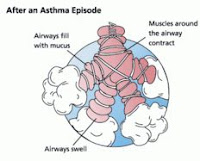 This multinational trial aimed to characterize the “frequent exacerbator” asthma phenotype and to identify risk factors associated with exacerbations.
This multinational trial aimed to characterize the “frequent exacerbator” asthma phenotype and to identify risk factors associated with exacerbations.93 severe asthmatics and 76 mild-to-moderate patients were prospectively followed for 1 year. During the study, 104 exacerbations were recorded in the severe asthmatics group and 18 in the mild-to-moderate group.
Frequent exacerbators were characterized by:
- use of higher doses of inhaled (1700 vs. 800 μg) and oral (6.7 vs. 1.7 mg) glucocorticosteroids
- worse asthma control (ACQ score 2.3 vs. 1.4)
- lower quality of life
- higher sputum eosinophils (25.7% vs. 8.2%)
- more rapid decline in FEV1 /FVC ratio
- exhaled NO greater than 45 p.p.b. and a history of smoking were associated with an increased risk of frequent exacerbations (odds ratios: 4.32 and 2.90 respectively)
The researchers attempted to characterize a subphenotype of asthma subjects - frequent exacerbators - who are significantly more prone to exacerbations. Patients with FeNO > 45 p.p.b. and a history of smoking are at increased risk of frequent exacerbations and require close monitoring in clinical practice.
References:
Frequent exacerbators - a distinct phenotype of severe asthma. Kupczyk M, Ten Brinke A, Sterk PJ, Bel EH, Papi A, Chanez P, Nizankowska-Mogilnicka E, Gjomarkaj M, Gaga M, Brusselle G, Dahlén B, Dahlén SE; BIOAIR investigators. Clin Exp Allergy. 2014 Feb;44(2):212-21. doi: 10.1111/cea.12179.
http://www.ncbi.nlm.nih.gov/pubmed/24447083
Image source: Wikipedia, public domain.
No comments:
Post a Comment